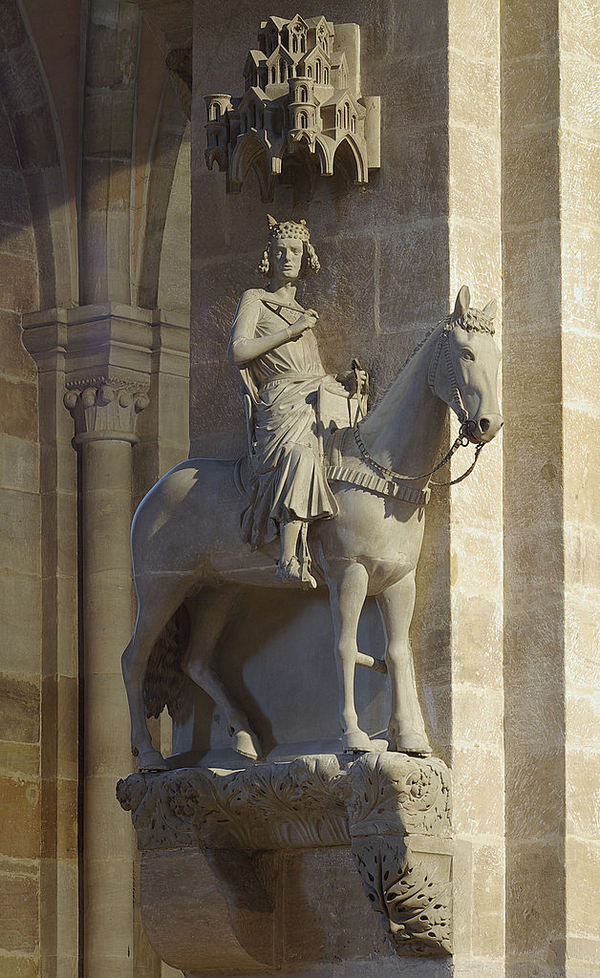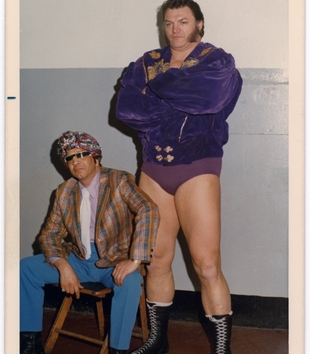A young king sits tall in the saddle, gazing intently at something in the distance. He wears a studded crown over his fashionable chin-length haircut, and pulls on a strap to draw his cloak closer around his shoulders. His horse stands at attention despite the loosely hanging reins, ears pricked forward and hind leg cocked as if ready to spring forward into action. Even if he were to receive a command, however, there is apparently nowhere for the steed to go: horse and rider are perched on a leafy pedestal that is just large enough to bear their life-size forms, and they have stood frozen there since they were carved into the fabric of Bamberg Cathedral in the thirteenth century.
Poetic and enigmatic, the Bamberg Rider has been a source of debate for art historians since the nineteenth century. Few medieval monuments have resisted interpretation as stubbornly as this apparently secular sculpture intruding so dramatically into sacred space. The truism that church art was created to structure religious experience is rarely challenged by medieval monuments, but this only makes the complete lack of overtly Christian signs or symbols in the Bamberg Rider all the more vexing. If the figure were intended to represent a popular knightly saint, such as Martin or George, he would bear some iconographic attribute to clarify this role—Martin would be accompanied by the beggar who shares his cloak, and George by the dragon that he conquers. The Rider could represent any one of a number of Old Testament kings, perhaps David or Solomon, or else a medieval Holy Roman Emperor such as Charlemagne or Frederick Barbarossa—but if this is the case, it remains strange that there are no visual hints to clarify which of these figures he might represent. The Rider could also stand for an ideal king, meant to embody the abstract concept of a good Christian ruler rather than a specific individual—but the presentation of such an idea in this form is unparalleled among Gothic sculpture.
Even if we turn away from the unsolvable riddle of who the Bamberg Rider might be, we are left with the even more unsettling problem of what exactly he might be doing in the cathedral. From written sources it is clear that riding a horse into a church was not entirely uncommon in the Middle Ages, but it is hard to see why anyone might wish to depict a life-size horse and rider inside the church. A large, ambitious sculpture such as this was surely made for a reason. Did church prelates hope to inspire greater piety among local aristocrats, or to impress the notion of aristocratic piety upon the lower classes? Was the Rider meant to be emulated, adored, or both? And what about the leaf-masked face of a Wild Man in the foliage underneath the horse’s front feet—did this add an allegorical dimension to the depiction of the rider? Did the composition point to a specific chapter in local history or folklore, or was it possibly just one more flourish added to the rich decoration of the cathedral?
These questions have attracted generations to enjoy the mystery of the Bamberg Rider. It is perhaps no surprise that his fierce expression also prompted the admiration of the Nazi party in the 1930s, when the Rider was taken up as an icon for German identity. There was, however, much irony and ignorance in this infatuation. The Nazis saw the Rider as a secular embodiment of racial purity, despite the fact that the art of thirteenth-century Bamberg was produced from a mix of French, German, and Italian traditions. Some also imagined that the Rider was facing East to conquer the Slavic nations, when in reality the sculpture gazes west, and the royal Saint Stephen of Hungary is among the likeliest candidates for the Rider’s identity. Stephen, who had been canonized in the eleventh century and was venerated as a saint at Bamberg, was a well-known model for ideal kingship in the thirteenth century. While the identification of the rider as Stephen remains unproven, it cannot be easily dismissed, and it underscores the problems inherent to Nazi concepts of “Germanic” identity and “secular” kingship. Whoever the Bamberg Rider may be, and however earlier audiences were meant to understand his presence in the cathedral, he represents a worldview in which religion and politics were fundamentally intertwined. His calm gaze seems to suggest that, despite the realities of shifting ethnic identities and complex national boundaries, medieval Europe could still dream of a world united under the paradigm of a perfect Christian king.
Notes
Imprint
10.22332/con.obj.2014.1
1. Shirin Fozi, "The Bamberg Rider," Object Narrative, in Conversations: An Online Journal of the Center for the Study of Material and Visual Cultures of Religion (2014), doi:10.22332/con.obj.2014.1
Fozi, Shirin. "The Bamberg Rider." Object Narrative. In Conversations: An Online Journal of the Center for the Study of Material and Visual Cultures of Religion (2014). doi:10.22332/con.obj.2014.1



